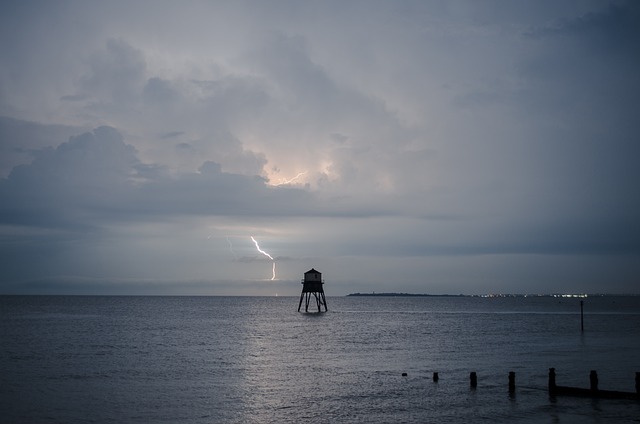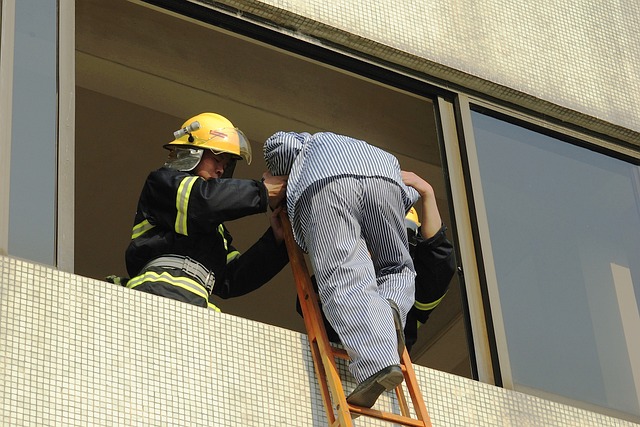In regions prone to severe storms, prioritizing robust construction and impact-resistant materials is crucial for maintaining home integrity and safeguarding occupants. Key strategies include adopting durable siding like fiber cement or vinyl with reinforcements, engineered shingles, and reinforced windows designed to withstand high pressure and flying debris. High-durability materials such as corrosion-resistant metals in roofing and structural elements further enhance longevity and stability. Advanced engineering and strategic material selection are essential for bolstering home safety against the destructive forces of nature, particularly in areas where historical storm data should inform property assessments to identify weak points that require reinforcement. Additionally, in flood-prone areas, installing storm surge protections like floodwalls is vital. Homeowners should focus on impact-resistant windows and shutters, reinforced roofing options, and durable siding materials to protect their homes from the unpredictability of weather patterns and ensure resilience against potential storm damage, thereby maintaining home safety. The integration of reinforced concrete in critical structural elements and safe rooms provides enhanced protection for occupants during severe weather events. Overall, a comprehensive approach that combines robust materials with strategic design is essential for safeguarding homes and ensuring home safety in the face of storms.
When the winds howl and the skies darken, homeowners confront the raw power of nature. Ensuring a dwelling can withstand the fury of storms is paramount for home safety. This article delves into the critical role of durable materials in storm-proofing homes, offering insights into fortifying your abode against the capricious forces of weather. From reinforced concrete to hurricane-rated roofing materials, and from impact-resistant siding options to strategically designed landscapes, discover how to enhance your home’s resilience and safeguard it amidst the chaos of storms.
- Understanding the Importance of Durable Materials in Storm-Proofing Homes
- Assessing Your Home's Vulnerability to Storm Damage
- Top Durable Materials for Fortifying Your Home Against Storms
- – Reinforced Concrete and its Applications
- – Impact-Resistant Siding Options
Understanding the Importance of Durable Materials in Storm-Proofing Homes

In regions frequently battered by severe weather, the integrity of a home’s construction is paramount to ensure occupant safety and longevity. Durable materials are critical in storm-proofing homes as they can withstand the high winds, heavy rains, and flying debris associated with storms. For instance, impact-resistant siding and specially engineered shingles can significantly reduce the risk of damage from airborne projectiles. Homeowners should invest in materials that have been rigorously tested and certified for their resilience against natural elements to safeguard their properties effectively.
The choice of durable materials not only protects the structure but also its contents and the people within. Reinforced windows, designed to maintain integrity even under high pressure, can prevent the penetration of water and wind, thus minimizing interior damage and potential flooding. Additionally, the use of corrosion-resistant metals for roofing and other structural components can extend the lifespan of the home, ensuring it stands strong against the relentless test of time and nature’s unpredictable fury.
Assessing Your Home's Vulnerability to Storm Damage

Before implementing storm-proofing measures, it’s crucial to assess your home’s vulnerability to potential storm damage. Homeowners should conduct a thorough inspection of their property, focusing on areas prone to wind infiltration and water intrusion. Pay particular attention to the roof, windows, doors, and the foundation; these are common entry points for destructive storm forces. Utilize resources such as historical storm data from local meteorological offices to understand the types of storms your home may face. This information will help identify weak points that require fortification with durable materials, ensuring your home can withstand severe weather conditions.
Factors such as the age of your home, local geography, and proximity to water bodies are significant in determining your home’s vulnerability. Older homes, for instance, may have outdated construction methods that compromise structural integrity during high winds. Similarly, homes located in low-lying areas or near large bodies of water face a higher risk of flooding and should be equipped with storm surge protections like floodwalls or levees made from resilient materials. By understanding these factors and making informed decisions on which materials to use for reinforcement, homeowners can significantly enhance their property’s safety during storm events.
Top Durable Materials for Fortifying Your Home Against Storms

In the face of increasingly unpredictable weather patterns, fortifying one’s home against storms has become a priority for many. High-durability materials play a critical role in enhancing home safety and ensuring that structures withstand the fury of nature. Among the most robust options are impact-resistant windows and shutters, which are designed to protect against flying debris. These windows and shutters, often made from laminated glass or polycarbonate, can safeguard homes during storms and prevent costly damage. Additionally, reinforced roofing materials such as impact-resistant shingles or metal roofing systems can significantly reduce the risk of structural failure due to high winds or heavy impacts. These materials are not only resilient but also aesthetically pleasing, maintaining the integrity and appearance of your home.
Furthermore, storm-proofing your home extends beyond windows and roofs; it includes the use of durable siding materials like fiber cement or engineered wood that can withstand the elements over time. These materials are specifically engineered to resist warping, swelling, and decay, ensuring that your home’s exterior remains intact during severe weather conditions. Moreover, the integration of proper sealing and waterproofing systems, combined with these durable materials, creates a formidable defense against water intrusion, which is one of the leading causes of damage in storms. By investing in high-quality, durable materials for storm-proofing your home, you are taking proactive steps towards maintaining home safety and minimizing potential disaster costs.
– Reinforced Concrete and its Applications

In fortifying homes against the destructive forces of a storm, reinforced concrete stands out as a robust material for construction and storm-proofing. Its high strength-to-weight ratio, combined with its exceptional durability, makes it an ideal choice for structural elements that must withstand high winds, flying debris, and heavy rainfall. Reinforced concrete’s resilience is amplified by the addition of steel bars or mesh, which act as a support framework, further enhancing its ability to resist the pressure exerted by storms. This composite material ensures that critical components of a home, such as walls and foundations, remain intact even under the most adverse weather conditions, thereby safeguarding occupant safety during storm events.
The application of reinforced concrete in storm-proofing extends beyond just the primary structure; it is also effectively utilized in creating safe rooms within the home. These rooms, designed to be the most secure spaces during a storm, are constructed with thicker walls and reinforced concrete roofs that can shield occupants from flying debris and high winds. The use of this material in windows and doorframes, where hurricane impact-resistant glass is integrated, further enhances home safety by providing an additional layer of protection against storm impacts. This strategic placement and application of reinforced concrete are crucial in designing homes that are both resilient and safe during the unpredictable onslaught of a storm.
– Impact-Resistant Siding Options

In regions frequently beset by storms, selecting impact-resistant siding is paramount for maintaining home safety. Vinyl and fiber cement siding stand out due to their exceptional durability and resilience against high winds and flying debris. Vinyl siding, in particular, offers a lightweight yet robust option that can withstand impacts without sustaining significant damage, often coming with built-in reinforcements for added protection. Fiber cement siding, known for its toughness and longevity, is engineered to endure harsh weather conditions, providing an additional layer of defense against the elements during a storm. Both materials are designed to maintain their structural integrity even under extreme pressure, thereby safeguarding your home from the ravages of high-velocity windstorms. Homeowners looking for impact-resistant siding options that prioritize storm protection will find both vinyl and fiber cement to be prudent choices for enhancing home safety and enduring the unpredictability of nature.
In concluding this discussion on durable materials for storm-proofing homes, it’s clear that homeowners can significantly enhance their property’s resilience against the capricious fury of storms. By understanding the vulnerabilities of their homes and selecting robust construction materials like reinforced concrete and impact-resistant siding, residents can bolster defenses against high winds, flying debris, and torrential rain. These strategic choices in material selection are not just about weathering a storm; they’re about ensuring home safety and maintaining structural integrity. As such, homeowners should prioritize these fortifications to safeguard their homes and the well-being of their families against the unpredictable nature of storms. With careful planning and the implementation of resilient building materials, the sanctuary of one’s home can remain steadfast even in the face of nature’s most potent forces.
